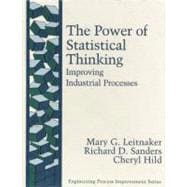The topics in this book are intended to provide the statistical background necessary for the manager or engineer to assume these responsibilities. Presentation of the statistical methods and tools is supported by demonstration of correct use, practice, interpretation, and guidance for implementation. Clearly, a knowledge of statistics is insufficient by itself to provide the type of knowledge and guidance needed for process improvement. A critical component of improvement work is the management and technical knowledge brought to bear on determining where and how to employ the statistical techniques. The required knowledge of chemistry, physics, and of a host of applied engineering methods are not covered in this book. There is nothing directly on "people management skills." Instead, the book contains advice, based on observation and experience, as well as numerous case studies on the integration of statistical methods with management and engineering knowledge, which can lead to organizational improvement.
Just as the roles of managers and engineers are changing in organizations, so are the uses of statistical methods in organizations. This change in the manner in which statistical methods are being used is reflected in recent writings by W. E. Deming (1986) and Ronald D. Moen, Thomas W. Nolan, and Lloyd P. Provost (1991) on enumerative and analytical methods in statistics. Enumerative methods, although primarily intended for studying a fixed population of items, have formed the bulk of statistical techniques taught at the undergraduate and graduate levels in statistics courses for managers and engineers. A perusal of the table of contents of most statistical textbooks designed for these audiences would verify this statement. Analytical statistical methods, on the other hand, are intended to provide insights into the causal mechanisms affecting the outcomes of ongoing processes. Processes occurring over time are subject to changes in environment, materials, methods, equipment, and other circumstances. It is the study of process behavior and how it is affected by these changing circumstances that is addressed by analytical studies.
The demands for increased statistical skills for process investigation in the industrial world has had an effect on the content of statistical courses in universities and colleges and on professional education. There are a growing number of competent statistical books that present the basic formulas of statistical process control. In general, those books focus on the use of statistics as strict control or feedback mechanisms; they provide little demonstration of the use of these methods for the analytical studies required for identifying sources of variation. This book is intended not only to teach statistical techniques useful in such analytical studies, but also to illustrate how these techniques can be used in practice to understand the causal mechanisms that determine the output characteristics of processes and provide insights into the improvement of these processes. Some statistical theory is covered in an appendix. When used as a course text, the instructor can increase the value of the book by demonstrating the utility of theory in approaching a new situation, in searching for the correct technique, and by demonstrating and discussing the constraints often found in unspoken mathematical and process-based assumptions.
Acknowledgments
The examples and ideas in this textbook are primarily the result of the authors' association with the University of Tennessee's Management Development Center. Although too numerous to name, managers and engineers from industry who have attended U.T.'s executive education courses have provided numerous ideas, insights, and critiques of the thoughts in this book. The authors would like to express their appreciation to John Riblett, the center's director, for his considerable efforts in supporting the growth of faculty and ideas through his management of the center. Also, without the advice, support, and insights from our faculty colleagues at the center this book would not have been possible.
0201633906P04062001








